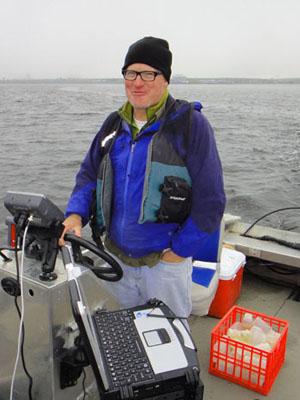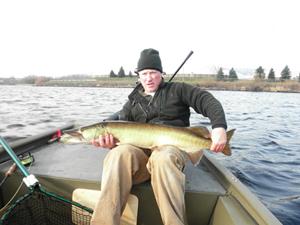Meet EPA Biologist Theodore Angradi, Ph.D.

Exploring Aquatic Ecosystems
Theodore Angradi, Ph. D., is a research biologist whose early work with EPA focused on ecosystem monitoring and assessment for some of the largest rivers in the United States. Dr. Angradi has been involved in large river research for about 18 years, and has worked on the Snake River in Idaho, the Colorado River in Arizona, and the Missouri River in North Dakota. More recently, his work has been centered on the Great Lakes Areas of Concern. Specifically, he is interested in how the environmental clean-up and waterfront revitalization of the Great Lakes can benefit humans and their well-being.
How does your science matter?
My current research looks at the importance of restoring and protecting aquatic habitats in the Great Lakes region. These habitats have important functions, such as providing places for fish to live and grow, cycling nutrients, and providing clean water.
Recently, I have been using underwater video to do benthic assessments of nearshore habitat in the Great Lakes. Underwater video is a very efficient way to determine the presence of invasive species that are other not vulnerable to traditional sampling methods.
When I'm not in the field, I'm crunching numbers, writing papers, and mentoring students and post-docs.
If you could have dinner with any scientist, past or present, who would you choose and what would you ask them?
I'd say Friedrich Wilhelm Heinrich Alexander von Humboldt. Humboldt was the polymath’s polymath. He was an amazing character and scientist. More species are named after Humboldt than after any other human being. I suppose I would just ask him what it was like have his mind open to so much information.
What do you like most about your research?
I really like working with a team. Publishing papers that will be out there forever is also a good feeling.

Tell us about your background.
I received my bachelor’s degree in wildlife management from Virginia Tech University. I got a master’s degree in wildlife and Fisheries Science from Penn State University and my Ph.D. in Biology from Idaho State University.
How did you get started at EPA?
I was working for the Forest Service in West Virginia and wanted to move on to something new. I was lucky enough to find a research position at the EPA office in Denver, where I worked until I moved with my family to my current position in EPA's research lab in Duluth, Minnesota.
When did you first know you wanted to be scientist?
I was probably in grade school. Very early I knew I would be doing something with biology. I grew up at the New Jersey shore, so I spent a lot of time splashing around in the ocean and in Barnegat Bay and learning about what I saw and how it worked.
If you were not a scientist, what would you be doing?
I'd either be a fishing guide (I'm an avid fisherman) or a boat captain. Something on the water.
Any advice for students considering a career in science?
If you are interested in science, you need to think pretty carefully about the kind of classwork you do. You'll need to know the fundamentals of statistics. If you think you're going to be a biologist, you should pick a group of organisms you are interested in and really try to learn everything you possibly can about that group. It's important not to overspecialize, but it's important not to over-generalize, too. It also doesn't hurt to volunteer and find internships to get experience.
Editor's Note: The opinions expressed herein are those of the researcher alone. EPA does not endorse the opinions or positions expressed.
